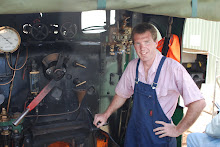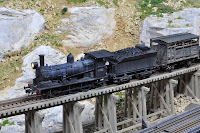Last October at the AMRA exhibition my good friend Graham Quinn snapped up from Mr Cunningham some Eureka 38's that were Duds. Available were tenders and Mechs, Both with bodies, sold as separate units. We were told that the problems with each unit were unknown but were faulty. Graham was able to put together 3x 38's total.
Returning home after the show the units were coupled with the mechs. He ended up with matching 3801 loco and tender, 3830 Loco and tender and the odd one out 3805 and a 3830 tender. I was asked to asses the units to see what was actually wrong. As it turned out both matching units worked perfectly and unbeknown to Ron they were all sound units. At first the third unit would not work. Knowing that the first two worked OK we tried the working tenders with the 'Dud' Loco and as I thought, it worked fine. My intentions then were to remove the IC chip from the working unit and put into the non working unit thinking that this may be the problem. Bingo! worked Perfect. I then reinstalled the Dud chip into the other tender and to my surprise worked great..... and still is. We now had all three 38's working fine with sound. What was wrong with them Ron?
One issue that now arose was the colour difference in the two greens of the 3805 and 3830's tender. Graham asked if I could weather the two and hide the colour difference. It was agreed that the colour difference was too dramatic. Graham was going to wait till the next show and buy chance pick up a 3805 tender however silly me suggested to repaint the whole loco, but I was NOT going to re line a green 3805. Graham already had a couple Brass black ones so that was out........"How about Grey"?.
Now the work begins.
I stripped the whole loco down. Even separating the cab, running boards and details from the boiler. The tender body was also separated from the chassis along with all the pressed on details. I masked up the silver sides of the firebox as I wanted these left this colour.
 |
| 38 Stripped and ready for paint. |
I then proceeded to air brush the whole loco with a mixed up 'close enough' grey. I let this dry for a few days.
90% of all the grey was masked off ready for the black. I use a automotive etch black made by Wattyl. I painted all the wheels along with all areas to be black. I was then able to reassemble the loco applying all the appropriately painted details. Ladder, power reverse, air pump etc. Nickle silver numbers were used for the cab sides along with Brass builders plates. I was unable to source black decals for the number on the back of the tender so I painted brass numbers black and applied these with a small amount of PVA.
All three 38's now received my black wash mixture using the Water mixable Oils and a little weathering with the air brush to finish off. The end result was very pleasing for a few 'dud' locos!
 |
| Completed 3801 in Grey. |
 |
| Green 3801 with Very Light weathering. |
I have mentioned that I have been busy working on the extensions to my house. Although not real exciting it is coming along fairly rapidly. We are just waiting for the tiler to tile the bathroom floor and hall before the skirting boards go on. The exciting part is the next job is the Train room slab. Father in law has been busy preparing the ground for Crusher dust and has started on digging the footings. Exciting Stuff! Will keep you posted on progress.
Well that's enough for now. Hope you all have a Merry Xmas and that Santa Bring lots of Trains!
Ho Ho Ho Chuff Chuff Chuff.
Ian























































.JPG)